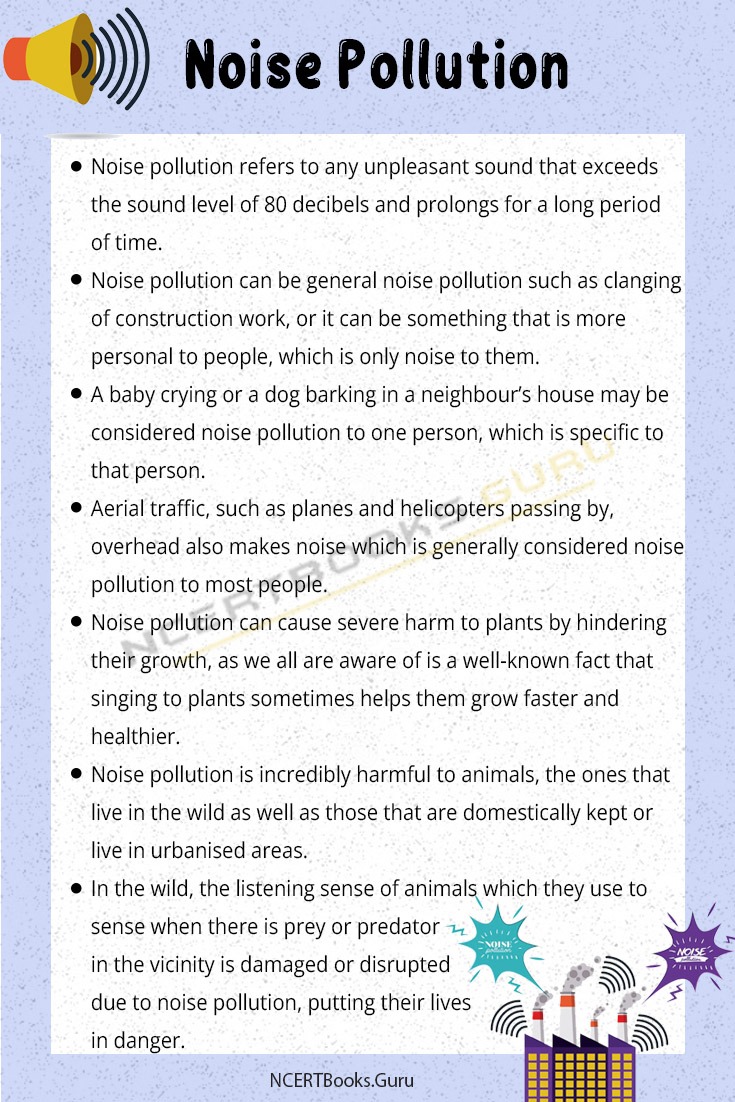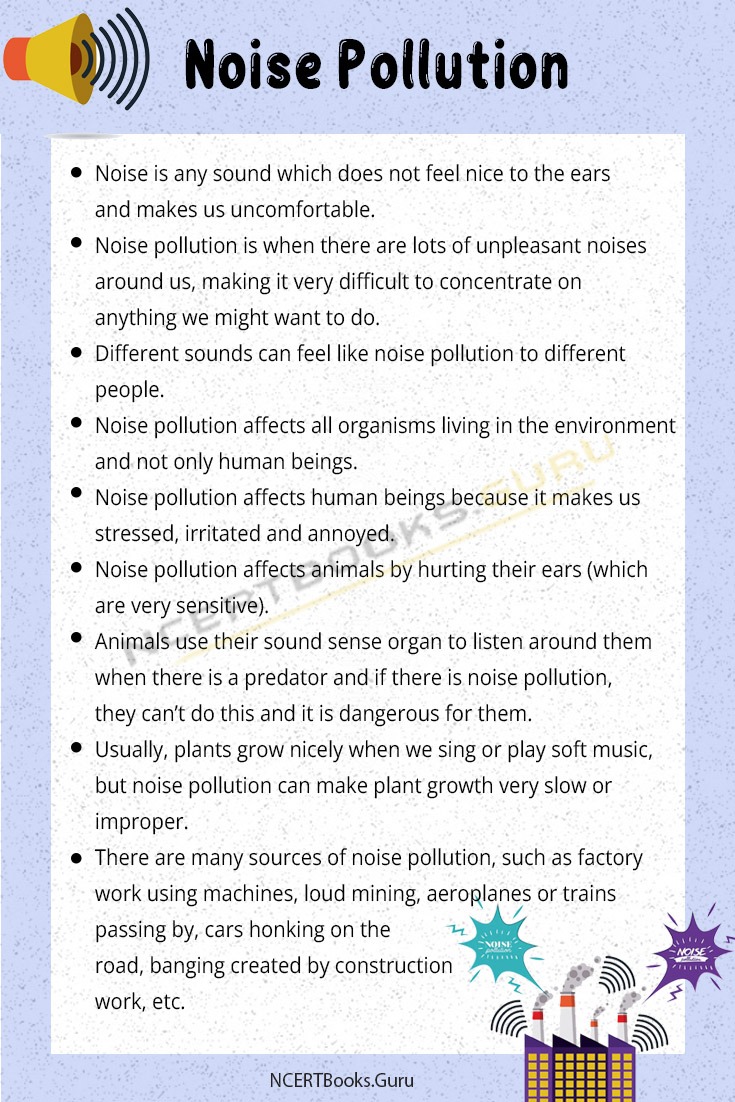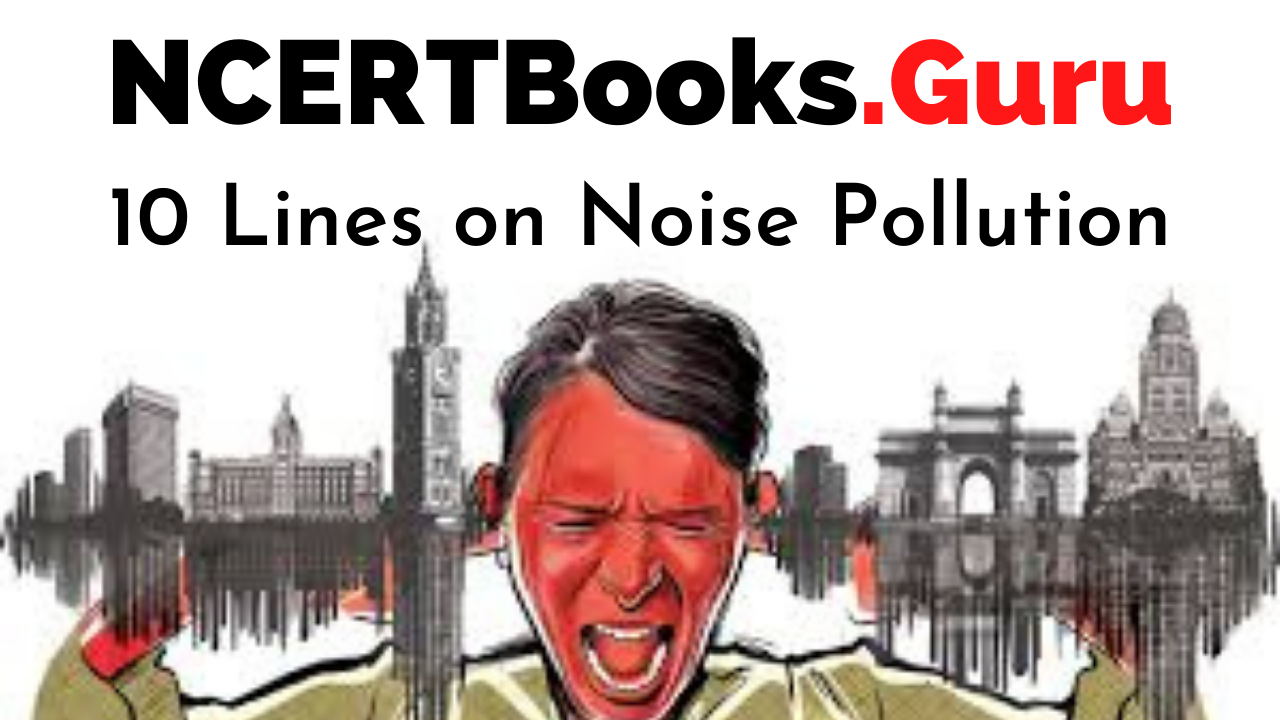10 Lines on Noise Pollution: Noise pollution is one of the four forms of pollution and it affects not only human beings, but also all other living beings such as plants and other animals.
Noise is defined by any unpleasant sound, which means that different sounds can sound like noise pollution to different people. However, the common sources of noise pollution are the honking of cars on the roads, the whirring of machinery in factories, the banging of construction sites, the crying of infants in public spaces, among various other things.
Below, there are three sets of 10 lines of noise pollution which will be useful for students who are looking to write essays or write assignments about one of the four forms of pollution – noise pollution.
Enhance your vocabulary and writing skills with 10 Lines Essays available. Spark up the creativity in you and access various Topics on 10 Lines all in one place.
Set 1 – 10 Lines on Noise Pollution for kids
The following set of 10 lines on noise pollution will be useful for students and children who are in classes 1, 2, 3, 4 and 5.
- Noise is any sound which does not feel nice to the ears and makes us uncomfortable.
- Noise pollution is when there are lots of unpleasant noises around us, making it very difficult to concentrate on anything we might want to do.
- Different sounds can feel like noise pollution to different people.
- Noise pollution affects all organisms living in the environment and not only human beings.
- Noise pollution affects human beings because it makes us stressed, irritated and annoyed.
- Noise pollution affects animals by hurting their ears (which are very sensitive).
- Animals use their sound sense organ to listen around them when there is a predator and if there is noise pollution, they can’t do this and it is dangerous for them.
- Usually, plants grow nicely when we sing or play soft music, but noise pollution can make plant growth very slow or improper.
- There are many sources of noise pollution, such as factory work using machines, loud mining, aeroplanes or trains passing by, cars honking on the road, banging created by construction work, etc.
- It is important to make sure that you yourself aren’t making any sounds which can be noise pollution for someone else.

Set 2 – 10 Lines on Noise Pollution for School Children
The following set of 10 lines on noise pollution will be useful for students who are in classes 6, 7, 8 and 9.
- Noise pollution refers to when any organism is exposed to an unpleasant sound for a certain period of time and it can affect their functioning.
- In specific terms, noise pollution refers to sounds over the level of 80 decibels which prolong for quite a few hours in the day and can be harmful to the life around them.
- Noise pollution affects the plants in the environment by hindering their growth, as compared to when plants are made to hear pleasant sounds.
- Noise pollution affects animals in the wild as well as in urbanised areas by disturbing their highly sensitive ears, causing them irritation and also causing them to lose a sense of their predators.
- For humans, noise pollution can have effects like stress, inability to sleep, severe mental disturbance with the inability to focus or concentrate on a task at hand, etc.
- For all organisms, the more uncontrollable, unpredictable and intense the sound is, the worse its effects will get.
- The most common source of noise pollution all over the world is the noise made by aeroplanes and trains, machinery in factories and the noises coming from construction sites.
- Other common sources of noise pollution are loud honking in the streets, noise from celebrations or parties coming from neighbouring homes, etc.
- It is important to be mindful that you are not creating noise pollution for someone else.
- If noise pollution bothers you too much and it is very out of your control, buying a pair of noise-cancelling headphones could be very helpful.
Set 3 – 10 Lines on Noise Pollution for Higher Class Students
The following set of 10 lines on noise pollution will be useful for students who are in classes 10, 11 and 12.
- Noise pollution refers to any unpleasant sound that exceeds the sound level of 80 decibels and prolongs for a long period of time.
- Noise pollution can be general noise pollution such as clanging of construction work, or it can be something that is more personal to people, which is only noise to them.
- A baby crying or a dog barking in a neighbour’s house may be considered noise pollution to one person, which is specific to that person.
- Aerial traffic, such as planes and helicopters passing by, overhead also makes noise which is generally considered noise pollution to most people.
- Noise pollution can cause severe harm to plants by hindering their growth, as we all are aware of is a well-known fact that singing to plants sometimes helps them grow faster and healthier.
- Noise pollution is incredibly harmful to animals, the ones that live in the wild as well as those that are domestically kept or live in urbanised areas.
- In the wild, the listening sense of animals which they use to sense when there is prey or predator in the vicinity is damaged or disrupted due to noise pollution, putting their lives in danger.
- In urbanised areas like towns, villages, cities, etc. animals are subject to a lot of noise pollution which can be painful to their ears, which are highly sensitive as compared to human ears – animals hear sounds of frequencies that are unheard by the human ear.
- In humans, noise is the most harmful when it is out of the control of the person whom it is bothering when it is persistent and its intensity is very high.
- In human beings, noise pollution can have several disastrous effects, such as the inability to concentrate, the inability to sleep, constant mental pressure, etc.

Frequently Asked Questions on Noise Pollution
Question 1.
What is noise pollution?
Answer:
Noise pollution refers to certain sounds which are unpleasant to the ear and are prolonged for a period of time. The WHO roughly defines noise pollution as a prolonged irritating sound which exceeds the noise level of 80 decibels. Noise pollution can be harmful to all the organisms that are in their vicinity.
Question 2.
Does noise pollution affect plants?
Answer:
It is a widely known fact that singing to plants or playing soft, melodious music for plants can help them with healthy and fast growth. Noise pollution has the severely opposite effect on plants, in that loud, jarring noises can hinder the growth of a plant and also reduce how healthy it is.
Question 3.
What is a decibel?
Answer:
Decibel refers to the unit value we use to measure how loud and big a sound is. It measures the frequency of the sound and tells us how loud it is. Sounds below 70 decibels are fine, but those above 80 decibels, especially when prolonged, are termed as noise or noise pollution.
Question 4.
What are some examples of noise pollution?
Answer:
Some examples of noise pollution are:
- Noises from construction sites
- The noise of aeroplanes or trains
- Honking by vehicles on the road
- Firecrackers
- Whirring of machines in factories
